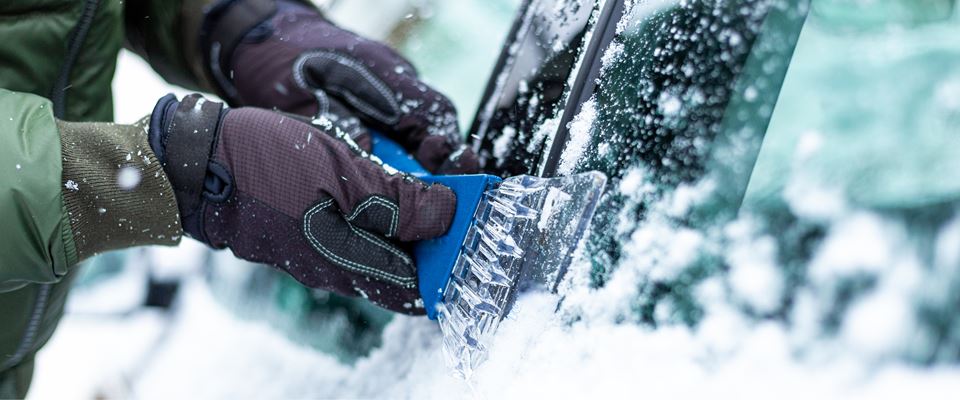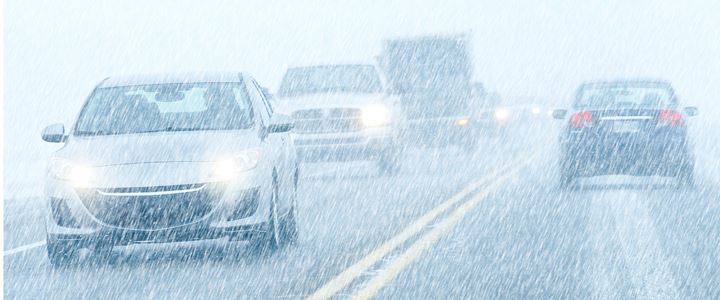There are 262,900 miles of road in the UK's road network - that's further than a trip to the moon.1 With over 32m licensed cars in the UK at the end of 2020,2 roadscan get a little crowded from time to time. When you factor in the conditions that the winter months bring, it's more important than ever to be even more prepared. According to the Weather Channel, weather-related vehicle accidents kill more people every year than large-scale weather disasters.3 So here are some simple tips to ensure your vehicle, and therefore your journey, is as safe as possible.
Keep the car healthy
Oil should be changed every 3,000 miles, but with modern lubricants most engines today have recommended oil change intervals of 5,000 to 7,500 miles.4 Keep your tyres at the optimum pressure level (the law requires you to have your tread depth at a minimum of 1.6mm, but grip starts to reduce on anything under 3mm, so make sure you keep an eye on your tyres and replace them if needed). Winter driving can often cause dirt and grit to cover the windscreen, which can restrict your visibility if not cleaned, keep your windscreen wash topped up. Check your lights are all working correctly, not only do you need to be able to see if visibility is reduced, others need to be able to see you too.
Check your battery
As well as basic health checks on your car, you need to be aware of the extra demands winter makes on our vehicles. Car batteries rarely last longer than five years, but in winter, increased use of lights, heating and wipers will use their power more quickly. Turn off electrical loads like lights, heated rear window and wipers before starting the engine. If the engine doesn't start quickly, wait 30 seconds between attempts. If you don't use your car often, trickle chargers can be left on your vehicle for lengthy periods in order to recharge your car battery. It will slowly add the charge to the battery and will in this way prevent your car battery from losing its charge.
Most batteries in electric vehicles are lithium-based. A lithium battery is liable to lose capacity for every full charge and discharge it undergoes, a process that’s called a cycle. Other than being mindful of how you use and charge the battery, other ways to care for it include keeping your electric car in a garage to maintain a constant temperature and avoid exposing the battery to extreme heat or cold.
Antifreeze awareness
Antifreeze only costs a few pounds, but a frozen and cracked engine costs hundreds to repair. Antifreeze, also known as coolant, plays an essential role in keeping your car’s engine working in both hot and cold conditions. Failing to keep your antifreeze topped up can cause significant damage to your car’s engine. Keep an ice scraper in your car so you can clear your windows and lights. It might be tempting, but don't pour hot water on a frozen windscreen, it may cause the glass to crack.
Be breakdown ready
We have excellent breakdown companies in the UK, but the average wait time is still around an hour. As the RAC and AA dominate the market (looking after 70% of roadside repairs between them),4 we do need to rely on their expertise. Still, of course, there are other things we can do to keep safe if we breakdown. So long as it’s safe to do so, leaving the car is the first priority. Find a safe spot and ensure you have a blanket, a torch, a fully charged phone, some food and any other essentials you think you may need if you find yourself waiting to be recovered in winter. Keep a warning triangle in your boot so that you can alert other drivers to your presence as they approach.
Ensure your winter admin is up to date
Has your car had its scheduled service? Make sure you’re up to date with this to help keep it in tip-top condition. It’d be worth considering a quick health check by a professional before the colder months kick in.
Ensure your vehicle insurance is up to date and that all drivers and journey purposes are included on your policy. Know the conditions of cover before setting off. Check your roadside cover is valid in case of an emergency and if you are making longer journeys in winter, keep people informed of your route and timescales so they know when you are due to arrive.
Slow down and keep your distance
Stopping distances are longer in winter months, more people are likely to drive to work or school in bad weather, and it's not just snow and ice we have to deal with: heavy rain, wind and fog can all make driving just as tricky, affecting our vision as well as the road's surfaces. For this reason, we need to adjust our driving accordingly. Keep your speed down, keep calm and keep both of your hands on the wheel - consider driving gloves if it helps your grip. Allow extra time for all your journeys, so you are not rushing.
If there is a fault with your car, it's likely that the colder weather will expose this. It's now time to carry out those winter checks and adapt your driving habits if needed to ensure you and others are safe on the roads.
Sources:
1. https://toptests.co.uk/driving-statistics/
2. Number of Cars in the UK 2022 | NimbleFins
3. https://weather.com/safety/winter/news/weather-fatalities-car-crashes-accidents-united-states
4. https://www.aaa.com/autorepair/articles/how-often-should-you-change-engine-oil











